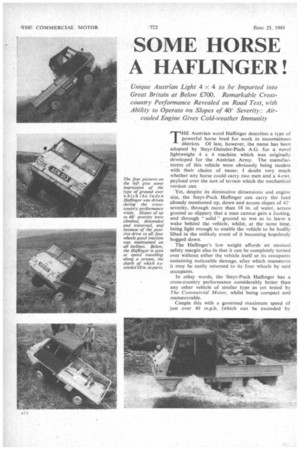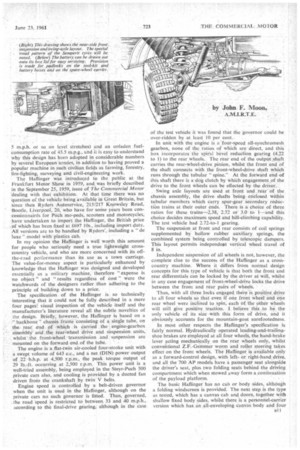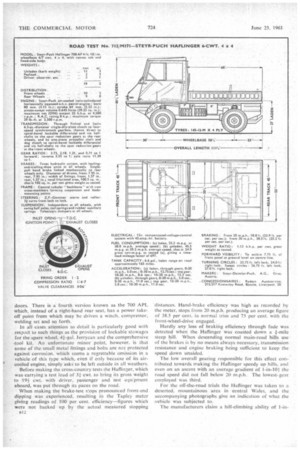SOME HORSE A HAFLINGER
Page 44

Page 45

Page 46

Page 47

If you've noticed an error in this article please click here to report it so we can fix it.
Unique Austrian Light 4 x 4 to be Imported into Great Britain at Below 000. Remarkable Crosscountry Performance Revealed on Road Test, with Ability to Operate on Slopes of 400 Severity .• Air
cooled Engine Gives Cold-weather Immunity by John F. Moon,
A.M.I.R.T.E. ,
THE Austrian word Haflinger describes a type of powerful horse bred for work in mountainous districts. Of late, however, the name has been adopted by Steyr-Daimler-Puch A.G. for a novel lightweight 4 x 4 machine which was originally developed for the Austrian Army. The manufacturers of this vehicle were obviously being modest with their choice of name: I doubt very much whether any horse could carry two men and a 4-cwt payload over the sort of terrain which the mechanical version can.
Yet, despite its diminutive dimensions and engine size, the Steyr-Puch Haflinger can carry the load already mentioned up, down and across slopes of 43' severity, through more than 18 in. of water, across ground so slippery that a man cannot gain a footing, and through " solid " ground so wet as to leave a wake behind the vehicle, whilst, at the same time, being light enough to enable the vehicle to be bodily lifted in the unlikely event of it becoming hopelessly bogged down.
The Haflinger's low weight affords an unusual safety margin also in that it can be completely turned over without either the vehicle itself or its occupants sustaining noticeable damage, after which manceuvre it may be easily returned to its four wheels by said occupants.
In other words, the Steyr-Puch Haflinger has a cross-country performance considerably better than any other vehicle of similar type as yet tested by The Commercial Motor, whilst being compact and manceuvrable.
Couple this with a governed maximum speed of just over 40 m.p.h. (which can be exceeded by 5 m.p.h. or so on level stretches) and an unladen fuelconsumption rate of 45.5 m.p.g.. and it is easy to understand why this design has been adopted in considerable numbers by several European armies, in addition to having proved a popular machine in such civilian fields as farming, forestry. fire-fighting, surveying and civil-engineering work.
The Haflinger was introduced to the public at the Frankfurt Motor Show in 1959, and was briefly described in the September 25, 1959, issue of 'The Commercial Motor dealing with that exhibition. At that time there was no question of the vehicle being available in Great Britain, but since then Ryders Autoservice, 215/217 Knowsley Road, -Bootle, Liverpool, 20, who have for some years been concessionnairCs for Puch mo-peds, scooters and motorcycles, have undertaken to import the Haflinger, the British price of which has been fixed at £697 10s., including import duty. All versions are to be handled by Ryders', including a "de luxe "model with plastics cab.
In my opinion the Haflinger is well worth this amount for people who seriously need a true lightweight crosscountry vehicle, and who are more concerned with its offthe-road performance than its use as a town carriage. The value-for-money aspect is particularly enhanced by knowledge that the Haflinger was designed and developed essentially as a military machine, therefore "expense is no object" and "results regardless of cost" were the watchwords of the designers rattier than adhering to the principle of building down to a price.
The specification of the Haflinger is so technically interesting that it could not be fully described in a mere four pages: visual inspection of the vehicle itself and the manufacturer's literature reveal all the subtle novelties of the design. Briefly, however, the Haflinger is based on a ." backbone chassis franie -consisting of a single tube, on the: rear end of 'which is carried the engine-gearbox asSernbly and the rear-wheel drive and suspension units, whilst the front-wheel -transmission and suspension are mounted on the forward end of the tube.
The engine is a flat-twin air-cooled four-stroke unit with a swept volume of 643 c.c., and a net (DIN) power output of 22 .13,11.p. at 4,500 r.p.m., the peak torque output of• 29 lb.-ft. occurring at 2,500 r.p.m. This power unit is a well-tried assembly, being employed in the Steyr-Puch 500 private cars also, and cooling is provided by a ducted fan driven from the crankshaft by twin V belts.
Engine speed is controlled by a belt-driven governor when the unit is used in the Haflinger, although on the private cars no such governor is fitted. Thus, governed, the road speed is restricted to between 33 and 40 m.p.h., according to the final-drive gearing; although in the case of the test vehicle it was found that the governor could be over-ridden by at least 10 per cent..
In unit with the engine is a four-speed all-synchromesh gearbox, none of the ratios of which are direct, and this box incorporates the spiral bevel reduction gearing (4.22 to 1) to the rear wheels. The rear end of the output shaft carries the rear-wheel-drive pinion, whilst the front end of the shaft connects with the front-wheel-drive shaft which runs through the tubular "spine." At the forward end of this shaft there is a dog clutch by which engagement of the drive to the front wheels can be effected by the driver.
Swing axle layouts are used at front and rear of the chassis assembly, the drive shafts being enclosed within tubular members which carry spur-gear secondary reduction trains at their outer ends. There is a choice of three ratios for these trains-2.38, 2.72 or 3.0 to 1--and this choice decides maximum speed and hill-climbing capability. The test vehicle had 2.72-to-1 gearing.
The suspension at front and rear consists of coil springs supplemented by hollow rubber auxiliary springs, the combined system being controlled by telescopic dampers. This layout permits independest vertical wheel travel of 8 in.
Independent suspension of all wheels is not, however, the complete clue to the success of the Haflinger as a crosscountry machine. Where it differs from normal design concepts for this type of vehicle is that both the front and rear differentials can be locked by the driver at will, whilst in any case engagement of front-wheel-drive locks the drive between the front and rear pairs of wheels.
Thus, with all three locks engaged there is positive drive to all four wheels so that even if one front wheel and one rear wheel were inclined to spin, each of the other wheels will still give positive traction. I believe this to be the only vehicle of its size with this form of drive, and it obviously accounts for the mountain-goat surefootedness.
In most other respects the Haflinger's specification is fairly normal. Hydraulically operated leading-and-trailingshoe brakes are employed at all four wheels, the hand-brake lever acting mechanically on the rear wheels only, whilst conventional Z.F.-Gemmer worm and roller steering takes effect on the front wheels. The Hollinger is available only as a forward-control design, with leftor right-hand drive, and all the 700 AP models have a passenger seat alongside the driver's seat, plus two folding seats behind the driving compartment which when stowed away form a continuation of the payload platform.
The basic Haflinger has no cab or body sides, although a folding windscreen is provided. The next step is the type as tested, which has a canvas cab and doors, together with shallow fixed body sides, whilst there is a personnel-carrier version which has an all-enveloping canvas body and four
doors. There is a fourth version known as the 700 API_ which, instead of a right-hand rear seat, has a power takeoff point from which may be driven a winch, compressor, welding set and so forth.
In all cases attention to detail is particularly good with resp....ct to such things as the provision of lockable stowages for the spare wheel. 4.1,--gal. Jerrycan and the comprehensive Stool kit. An unfortunate minor point, however. is that some of the small metal fittings and bolts are not protected against corrosion, which seems a regrettable omission in a vehicle of this type which, even if only because of its aircooled engine, simply asks' to be left outside in all weathers.
Before making the cross-country tests the Haflinger, which was carrying a test load of 3-1 cwt. to bring its gross weight to .194 cwt. with driver, passenger and test equ:pment aboard, was put through its Paces on the road.
When making the brake-test stops pronounced front-end dipping was experienced, resulting in the Tapley meter giving readings of 100 per cent. efficiency-figures which were not backed up by the actual measured stopping all distances. Hand-brake efficiency was high as recorded by the meter. stops from 20 m.p.h. producing an average figure of 38.5 per cent, in normal trim and 75 per cent, with the front-wheel-drive engaged.
Hardly any loss of braking efficiency through fade was detected when the Haflinger was coasted down a i-mile steep hill. When descending normal main-road hills use of the brakes is by no means always necessary, transmission resistance and engine braking being sufficient to keep the. speed down unaided.
The low overall gearing responsible for this effect contributed towards making the Haflinger speedy up hills, and even on an ascent with an average gradient of 1-in-101 the road speed did not fall below 20 m.p.h. The lowest-gear employed was third.
• For the off-the-road trials the Haflinger was taken to a deserted, mountainous area in central Wales, and the accompanying photographs give an indication of what the vehicle was subjected to.
The manufacturers claim a hill-climbing ability of 1-in 1.85 on dry ground for the version of the Haflinger that I tested: we exceeded this by a comfortable margin, ascending some short slopes of approximately 40°, which is equivalent to 1 in 1.2. In addition tei being able to go up and down such gradients, and stop on them in safety, it was also proved that the Haftinger could go across them without much fear of the vehicle toppling over, providing forward motion is continuous.
The particularly low centre of gravity of the Haflinger is a great help when traversing slopes, but the low engine position led me to wonder how the unprotected ignition
system would fare in water at least 18 in, deep. The Haflinger was taken along a fast-flowing, boulder-strewn stream of at least this depth, both backwards and forwards, and to my astonishment the engine never faltered once, although, on the debit side, braking efficiency seemed to be permanently reduced after about 15 minutes' submersion.
On the one occasion that the Haflinger did become bogged down—in some black, treacly mud bordering a tiny stream—the front of the vehicle was bodily lifted up by three of us until one wheel rested on firm ground, whereupon the Haflinger could be extracted under its own power. Ground clearance was sufficient to enable obstacles 1-ft. high to be cleared, whilst when " juniped " off the ground the 4 x 4 regained its feet in a most gentle manner.
Both on and off the road the vehicle handled very well and was in no way tiring to drive. The gearbox synchromesh was found to be very effective and the use of this mechanism on bottom gear also is valuable when crossing rough ground.
Maintenance, particularly of the engine, is easy to carry out. The hinged flap at the rear can be opened in two seconds, whereupon the engine oil level takes 17.5 seconds to check and the 'air-filter level 22 seconds. I cleaned the bowl of the petrol filter in 57 seconds. Further access to the engine is given by a cowl above the unit, which can be opened and propped up in eight seconds.
To gain complete access to the engine it is then necessary to remove the air-cooling cowl and the air-filter duct, operations taking 17 seconds all told, whilst replacement takes 47 seconds. With the cowl off I removed one of the sparking plugs in 23 seconds and replaced it in 28. The contact-breaker points gap can be set with the cowl id position, and thi operation took me 2 minutes 26 seconds.
Transniission oillevel checks all have to be done from: beneath the vehicle. The gearbox and. rear-differential level took 53 seconds to check and the frontdifferential 60 • seconds. The oil level in each of the four spur-gear housings took approximately 45 seconds to check. T h e . brake fluid reservoir is in the cab and its level can be tested in 15 seconds, whilst another job in the same area is that of checking the steering-box oil level—
25 seconds. The box is above the level of the toe board,
so is simple to reach.
All six fuses are housed behind a removable panel ahead of the steering column, and a fuse change took me only 17 seconds. The six-cell battery is housed in a sealed box beneath the left of the body floor, and the lid for this box hinges downwards to form a platform on to which the battery can be pulled out for attention, an arrangement which enabled me to check the cell levels in 45 seconds.
Following this I adjusted the brakes in a total time of five minutes, including jacking up each wheel, and as a final task I swopped the near-side rear and spare wheels in a total time of 2-1 minutes.
The Steyr-Puch Haflinger is an altogether unusual and fascinating vehicle, the many virtues of which become increasingly apparent as acquaintance with the machine grows. Although unconventional, the design is entirely practicable and I doubt if it has any true equivalent anywhere in the world in the civilian field. . Its successful performance undoubtedly hinges upon its small size— diminutiveness which gives no indication at first sight of the vehicle's true capacity for hard work.




















































































































